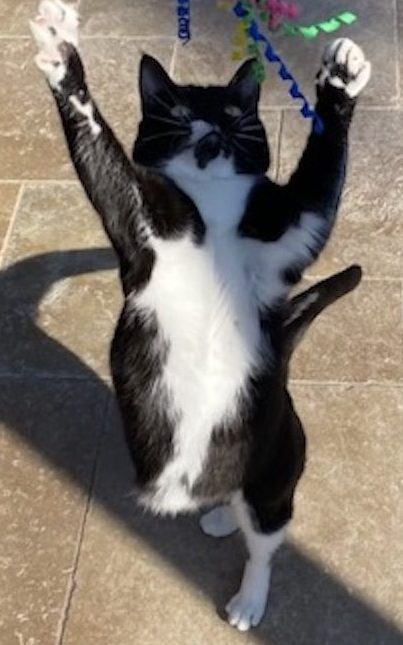
While Kitty’s housemates Tania and Nancy were out playing pickleball, they had no idea that their feline housemate was practicing her own game.
That is, until they came home early one afternoon to find Kitty reading Pickleball Fundamentals and practicing her serves.
“Who do you think you are?” Tania asked Kitty. “Pickles?”
She was referring to the dog who has been credited with the name behind one of the fastest-growing sports in the United States. But Kitty corrected her.
“The dog was named for the game,” she purred, “Not the other way around.”
It all began, Kitty chattered, in 1965 when necessity, the Mother of Invention, met Joel Pritchard, the Father of Pickleball. Although Joel had been an army sergeant in World War II, a congressman, a member of the Washington Senate and House of Representatives, and the state’s lieutenant governor, he is renowned for his response to a hot day, bored kids, a welter of equipment—and perhaps a dollop of guilt.
As the story goes, Joel and his friend Bill Bell returned from a golf outing to a buzzkill chorus from their kids of, “There’s nothing to do.”
Kitty could relate to that. She loves to be played with. That’s why she took up pickleball. “That’s why a lot of people play,” she said.
According to Joel’s son Frank, in a story posted on the Pickleball Hall of Fame blog, Joel suggested making up a game to relieve the boredom. After all, that’s what he did as a kid. So Frank, being a hot, bored kid, challenged him to do just that.
Although the property on Bainbridge Island, Washington, had a badminton court, there were no rackets or shuttlecocks. But Joel found some ping pong paddles and a wiffle ball.
Joel’s wife Joan lightheartedly named the game “Pickleball,” a deliberate reference to the thrown-together leftover non-starters in the “pickle boat” of crew races.
But Joel and Bill were not to be deterred. They made paddles out of plywood, tinkered with the height of the net, and eventually replaced the wiffle ball with an injection-molded one. Thrown together or not, this pickle of a game needed rules. Dads (especially if they’re legislators) like rules. So, Joel and Bill enlisted another dad, Barney McCullum, to devise the do’s and don’ts.
Kitty thinks that since they were inspired by a game named after a food, they came up with silly rules, like, stay out of the kitchen, i.e., the non-volley zone, and “dink” your opponent.

“You must consider the strategic aspect of the game,” Kitty explained. “It’s like chess. You need to out-think your opponent.”
What began as a hybrid of badminton, tennis, racquetball, and ping pong to appease some bored kids evolved into a competitive sport just a few years later.
In 1968, Pickle-ball, Inc. was created, “to develop the game … [and promote it] in a lawful manner.” By 1972, the company sold paddles, nets, and balls that were created specifically for the sport. The organization also helped transition the game into a legitimate sport. To wit, it was named the official state sport of Washington in 2022.
Between 1972 and 2022, the number of players skyrocketed, thanks to enthusiasts who brought their paddles with them from the Pacific Northwest to California, Arizona, Florida, and other Sun Belt regions. In Hawaii, the game became known as pukaball. Puka (meaning hole) referred to the game ball but eventually became the name of the game itself.
Over the last six years, the number of pickleball players has increased by 650%, according to USA Pickleball Association (USAPA), the sport’s official organization. Likewise, the Sports & Fitness Industry Association (SFIA) estimated that in 2017 there were 2.8 million pickleball players in the United States. Earlier this year, SFIA estimated 4.8 million players, making it the fastest-growing sport in the U.S.
Ironically, the sport that was created for bored children is synonymous with retirees. Yet USAPA reports that players over 55 make up only 30% of total players; 29% of players are in the 18–34 category; and remarkably, 6–17 year-olds make up 21% of all players.
Alas, pickleball injuries have also increased. The Journal of Emergency Medicine estimated 19,000 pickleball injuries in 2017, with 90 percent of them affecting people 50 and older. Noting that she and her housemates live in an active-adult community, Kitty reminded them that many of those injuries can be prevented by stretching, staying hydrated, and not backpedaling.
“It was a niche sport that started in the sixties,” Kitty demurred. “But now that baby boomers discovered it, it’s the rage.”
Nancy and Tania agreed. One proof of its popularity is the availability of specialized equipment and clothing that incorporates fabric technology with style. Another is the number of tournaments offered, and the increase in venues where the game is played. It can be found in virtually every municipal parks-and-recreation program across the country.
The Florida community where Tania, Nancy, and Kitty live recently increased the number of pickleball courts from 6 to 12. The courts are in constant use. That’s because most people play the sport for fun, fitness, and to reduce stress.
Just ask Kitty.

“If life hands you a pickle,” she said as she practiced a dink shot. “Start playing pickleball.”
Photos by Tania Batdorf

Now Available
Ghost Girl
One girl, two worlds, and 17 ghosts:
What if an alienated 12-year-old girl could reinvent her family and then lead it into the future?
Ghost Girl, by Patti M. Walsh, is a contemporary middle-grade novel based on Celtic mythology.
Now if only the kitty could find a way to muffle the noise for parkside homes, the evolution would be complete. Thanks for an entertaining history lesson on the sport!
LikeLike
Glad to learn the history of the sport. Pickleball is everywhere!
LikeLike
Cute story. I haven’t tried the game, but we have several courts in our neighborhood. I hope you are doing well.
LikeLike